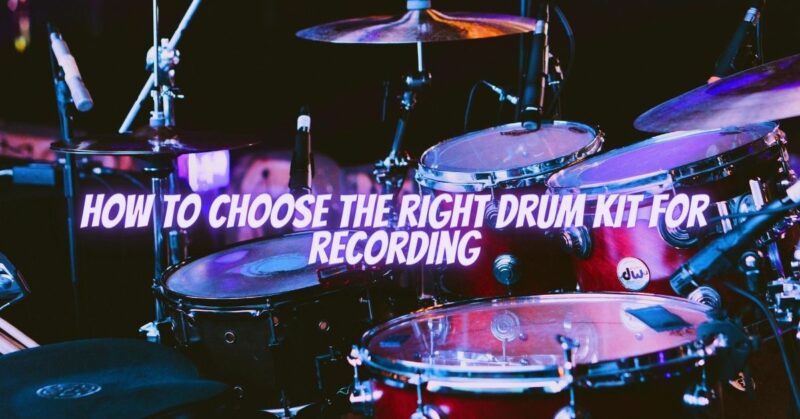Selecting the right drum kit for recording is crucial to achieving a professional and well-balanced drum sound in the studio. The drum kit’s tonal characteristics, construction, and overall quality significantly impact the recording quality and the ability to capture the desired drum sound. In this article, we will guide you through the process of choosing the ideal drum kit for recording, considering factors such as drum shell material, drum sizes, hardware, and tuning versatility.
- Drum Shell Material: a. Wood Shells: Most commonly used for their warm and resonant sound, wood shells, such as maple, birch, or mahogany, are a popular choice for recording. Maple provides a balanced tone with good projection, birch offers enhanced attack and clarity, while mahogany delivers a warm and rich sound. b. Acrylic Shells: Acrylic drum shells provide a distinct, focused, and bright sound with excellent projection and sustain. They offer a unique visual appeal and can produce a cutting sound that works well in certain recording contexts. c. Metal Shells: Metal shells, such as steel, brass, or aluminum, offer a bright, cutting sound with enhanced volume and projection. They can provide a focused and powerful sound that suits certain genres and recording styles.
- Drum Sizes: a. Consider the drum sizes in relation to the recording context. Smaller drum sizes, like 10″ and 12″ rack toms, and a 14″ or 16″ floor tom, produce a focused and tight sound that works well for punchy recordings. Larger drum sizes, such as 13″ and 14″ rack toms, and an 18″ or 20″ floor tom, offer more depth, sustain, and resonance that can suit larger recording spaces or genres that require a fuller sound. b. Experiment with different drum depths to achieve varying tonal characteristics. Shallower drums provide quick attack and focused sound, while deeper drums offer more body and sustain.
- Drum Hardware: a. Choose high-quality drum hardware, including lugs, hoops, and tension rods, that is durable and reliable. Well-built hardware ensures optimal drum performance and tuning stability during recording sessions. b. Consider the type of mounting system, such as traditional lug mounts or suspension mounts, as they can affect the drum’s resonance and sustain. c. Die-cast hoops provide enhanced rim shot clarity and tuning stability, while triple-flanged hoops offer more open and resonant sound.
- Tuning Versatility: a. Look for a drum kit that offers tuning versatility, allowing you to achieve a wide range of sounds for different recording scenarios. Experiment with various tuning combinations to find the sweet spot that suits the music style and recording environment. b. Drum kits with adjustable tom mounts and suspension systems provide flexibility in positioning the drums and can help optimize their sound for recording.
- Drumhead Selection: a. Choose drumheads that complement the desired sound for recording. Coated drumheads generally provide a warmer and focused sound, while clear drumheads offer more brightness and sustain. Experiment with different drumhead brands and models to find the perfect balance between attack, sustain, and overall tone.
- Studio Considerations: a. If you’re recording in a smaller studio space, consider drum kits with shorter sustain and controlled resonance to minimize the potential for muddiness or excessive room reflections. This can be achieved by selecting smaller drum sizes, using dampening materials, or utilizing drumheads with built-in muffling. b. In larger studios, drum kits with greater projection and sustain can capture the natural ambience of the room. Larger drum sizes and drum shell materials with enhanced resonance can contribute to a more spacious and immersive drum sound.
- Budget and Personal Preference: a. Consider your budget and personal preferences when choosing a drum kit for recording. While high-end drum kits offer superior craftsmanship and tonal quality, there are also affordable options available that can provide satisfactory recording results. Ultimately, choose a drum kit that meets your budget constraints and aligns with your musical preferences.
Conclusion: Choosing the right drum kit for recording involves considering various factors such as drum shell material, drum sizes, hardware quality, tuning versatility, drumhead selection, studio considerations, budget, and personal preferences. The ideal drum kit for recording should offer tonal characteristics that suit the music style, provide tuning flexibility, and be constructed with high-quality hardware. Remember to experiment with different drum setups, drumheads, and tuning options to achieve the desired drum sound for each recording session. With careful consideration and experimentation, you can select a drum kit that enhances your recording experience and helps you achieve exceptional drum tracks with clarity, depth, and musicality.


